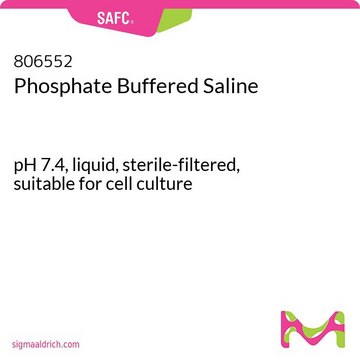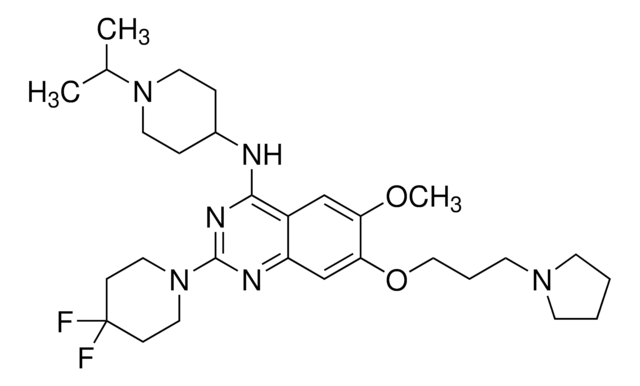2910
Whole Cell Extraction Kit
Iniciar sesiónpara Ver la Fijación de precios por contrato y de la organización
About This Item
UNSPSC Code:
41116012
eCl@ss:
32160405
Productos recomendados
manufacturer/tradename
Chemicon®
technique(s)
protein extraction: suitable
application(s)
sample preparation
shipped in
dry ice
storage temp.
2-8°C
Application
CHEMICON′s Whole Cell Extraction Kit (Catalog No. 2910) provides a simple and convenient method for the preparation of whole cell extractions for use in experimental studies of various cellular proteins.
This kit is recommended for use with CHEMICON′s Rac Activation Assay Kit (Catalog No. SGT425), Cdc42 Activation Assay Kit (Catalog No. SGT430), Ras Activation Assay Kit (Catalog No. SGT435), and CHEMICON′s Transcription Factor Assays when purified nuclear extracts are not required.
For Research Use Only; Not for use in diagnostic procedures
This kit is recommended for use with CHEMICON′s Rac Activation Assay Kit (Catalog No. SGT425), Cdc42 Activation Assay Kit (Catalog No. SGT430), Ras Activation Assay Kit (Catalog No. SGT435), and CHEMICON′s Transcription Factor Assays when purified nuclear extracts are not required.
For Research Use Only; Not for use in diagnostic procedures
Research Category
All
All
Components
Whole Cell Extraction Buffer, 5x: - (Part No. 90493) Two vials containing 10 mL of 5x concentrated buffer. Dilute to 1x final concentration with ddH2O prior to use.
Protease Inhibitor Cocktail: - (Part No. 90492) One vial containing 100μL of protease inhibitors in DMSO for use with mammalian cells and tissue extracts. A mixture of protease inhibitors with broad specificity for the inhibition of serine, cysteine, and aspartic acid proteases and aminopeptidases. Contains 4-(2-aminoethyl)benzenesulfonyl fluoride (AEBSF), pepstatin A, E-64, bestatin, leupeptin, and aprotinin. Contains no metal chelators. Prior to use, dilute 1/1000 in 1x Whole Cell Extraction Buffer.
Protease Inhibitor Cocktail: - (Part No. 90492) One vial containing 100μL of protease inhibitors in DMSO for use with mammalian cells and tissue extracts. A mixture of protease inhibitors with broad specificity for the inhibition of serine, cysteine, and aspartic acid proteases and aminopeptidases. Contains 4-(2-aminoethyl)benzenesulfonyl fluoride (AEBSF), pepstatin A, E-64, bestatin, leupeptin, and aprotinin. Contains no metal chelators. Prior to use, dilute 1/1000 in 1x Whole Cell Extraction Buffer.
Storage and Stability
· The 5x Whole Cell Extraction Buffer can be stored at 2-8°C until expiration date.
· The prepared 1x Whole Cell Extraction Buffer (with optional additives) should be stored at -20°C for up to one month.
· The undiluted Protease Inhibitor Cocktail can be stored at -20°C until the expiration date.
· The prepared 1x Whole Cell Extraction Buffer (with optional additives) should be stored at -20°C for up to one month.
· The undiluted Protease Inhibitor Cocktail can be stored at -20°C until the expiration date.
Legal Information
CHEMICON is a registered trademark of Merck KGaA, Darmstadt, Germany
Disclaimer
Unless otherwise stated in our catalog or other company documentation accompanying the product(s), our products are intended for research use only and are not to be used for any other purpose, which includes but is not limited to, unauthorized commercial uses, in vitro diagnostic uses, ex vivo or in vivo therapeutic uses or any type of consumption or application to humans or animals.
signalword
Danger
hcodes
Hazard Classifications
Aquatic Acute 1 - Aquatic Chronic 2 - Eye Dam. 1 - Skin Irrit. 2
Storage Class
10 - Combustible liquids
Certificados de análisis (COA)
Busque Certificados de análisis (COA) introduciendo el número de lote del producto. Los números de lote se encuentran en la etiqueta del producto después de las palabras «Lot» o «Batch»
¿Ya tiene este producto?
Encuentre la documentación para los productos que ha comprado recientemente en la Biblioteca de documentos.
Yuxuan Xiao et al.
Biochemical and biophysical research communications, 478(2), 919-923 (2016-08-16)
Sumoylation (a covalent modification by Small Ubiquitin-like Modifiers or SUMO proteins) has been implicated in the regulation of various cellular events including cell cycle progression. We have recently identified CDK1, a master regulator of mitosis and meiosis, as a SUMO
Andrew J Schneider et al.
Toxicological sciences : an official journal of the Society of Toxicology, 141(1), 176-187 (2014-06-15)
In utero exposure to 2,3,7,8-tetrachlorodibenzo-p-dioxin (TCDD) causes ventral prostate agenesis in C57BL/6J mice by preventing ventral prostatic budding in the embryonic urogenital sinus (UGS). TCDD (5 μg/kg, po) administered to pregnant dams on embryonic day 15.5 (E15.5) activates the aryl
F G Revel et al.
Molecular psychiatry, 18(5), 543-556 (2012-05-30)
Schizophrenia is a chronic, severe and highly complex mental illness. Current treatments manage the positive symptoms, yet have minimal effects on the negative and cognitive symptoms, two prominent features of the disease with critical impact on the long-term morbidity. In
Andrew J Schneider et al.
Gene expression patterns : GEP, 34, 119075-119075 (2019-11-02)
Previous studies identified Sox9 as a critical mediator of prostate development but the precise stage when Sox9 acts had not been determined. A genetic approach was used to delete Sox9 from mouse urogenital sinus epithelium (UGE) prior to prostate specification.
Yuxuan Xiao et al.
Biochemical and biophysical research communications, 487(3), 640-645 (2017-04-25)
The meiotic G2/M1 transition is mostly regulated by posttranslational modifications, however, the cross-talk between different posttranslational modifications is not well-understood, especially in spermatocytes. Sumoylation has emerged as a critical regulatory event in several developmental processes, including reproduction. In mouse oocytes
Nuestro equipo de científicos tiene experiencia en todas las áreas de investigación: Ciencias de la vida, Ciencia de los materiales, Síntesis química, Cromatografía, Analítica y muchas otras.
Póngase en contacto con el Servicio técnico








